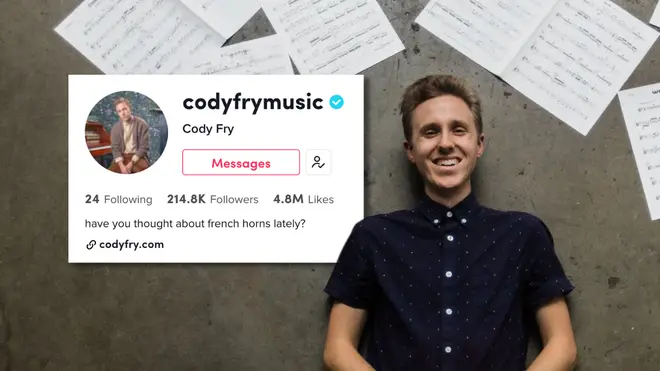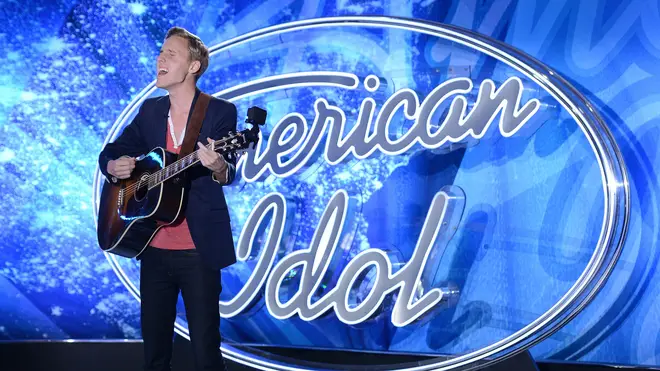On Air Now
Trust Me, It's A Classic with Alexander Dragonetti 9pm - 10pm
15 July 2022, 17:26 | Updated: 16 July 2022, 12:52

According to a new study, young people engage with orchestral music more on social media than in the classroom, so we called TikTok’s newest orchestral star, Cody Fry to ask why...
A recent survey commissioned by the Royal Philharmonic Orchestra revealed that 87% of children in the UK were engaging with orchestral music in their daily lives.
According to the research, this was more likely to be at home than in schools.
The most popular way young people reportedly engage with orchestral music is through film music. The next most popular way is listening to orchestral music on YouTube and other social media. Third on the list is by listening to orchestral music at school, during a music lesson.
So why are young people more likely to experience and engage with orchestral music at home? We spoke to 32-year-old breakout American TikTok star and orchestral composer, Cody Fry, to find out...
Read more: How TikTok is helping to discover the next generation of young classical talent

Eleanor Rigby - Cody Fry [Score Video]
Cody Fry’s arrangement of The Beatles 1966 song, Eleanor Rigby, sits at a pretty six million streams on YouTube.
The young composer received his first Grammy Award nomination (Best Arrangement, Instrumental and Vocals) for The Beatles track last year after rising to fame on TikTok for his original composition, I Hear a Symphony.
It was February 2021 when Fry noticed his Spotify numbers for I Hear a Symphony had shot up. The song, which was originally released in 2017, seemingly inexplicably rose to almost 100,000 listens a day on the music platform streaming platform.
It took a while for Fry to realise where this new traffic was coming from; the 32-year-old composer finally realised that his song had become a ‘sound’ on TikTok.
Fry isn’t the only composer whose music has skyrocketed to new audiences through TikTok fame. Earlier this year, pianist Ludovico Einaudi became TikTok's biggest classical composer, and his track Experience has 15.6 billion views and 6.8 million video creations to date on the short-form content creation app.
Debussy’s Clair de Lune is the 8th most popular sound being used on TikTok this week, sitting at 7.9 million views for the last 7 days, and in November last year, a #ClassicalMusic TikTok challenge racked up over 734 million views in less than a month.
Last month TikTok together with Warner Classics announced a new album titled, TikTok Classics - memes & viral hits. The album would be a world first, showcasing orchestral versions of 18 of the biggest sounds from the TikTok app.

Pianist performs amazing cover of Kate Bush's Running Up That Hill
“What I love about the music industry right now is that there are just no boundaries or rules or genres,” Fry explains when describing the rise of orchestral music on TikTok, “Gen Z in particular has really broken down all barriers in terms of listening and enjoying to music.
“They don't care if Kate Bush was big 30 years ago, they're just like, this is the first time we've heard this and it's dope.
“They don’t care if they’re listening to Debussy, or Max Richter, or John Williams, and they don't care what year it’s from.
“Their attitude is, this is great music and we enjoy this.”
Read more: The genius harmonic sequence that gives Kate Bush’s ‘Running Up That Hill’ its emotional power

I Hear a Symphony (Live) - Cody Fry's Symphony Sessions
Fry’s first break-out TikTok track, I Hear a Symphony ended up charting at #2 on the US Viral 50 chart and in the top ten on the Global Viral 50, charting in dozens of countries all over the world. The track was actually released on an album called Flying, four years before it would achieve viral fame.
Music runs in Cody’s family. His father, Gary Fry is also composer. As a child, Cody would watch his dad write jingles, commercial music for McDonald's and Nintendo and other big companies.
“I won the lottery as a kid,” Fry admitted. The composer originally Originally starting out as a singer-songwriter, who also wrote cinematic film “stuff” on the side. As a singer, he even appeared as a contestant on the 14th season of American Idol. Eventually he would combine his two passions into ‘orchestral pop’.
“Before TikTok, I didn't think anybody really wanted to see me do the film/cinematic music I was so interested in, but then right before my 2017 album, Flying, I thought why am I keeping this part of my music making separate from my singer-songwriting? They're both such a part of who I am. Why don't I just try to create something that really only I could create with my two different backgrounds?
“TikTok users love using music to score their experiences and the content they're creating. So a song like I Hear a Symphony has a certain cinematic quality that people wanted to use to illustrate these beautiful moments in their lives.
“There's so many different types of music that go viral on Tiktok, but a lot of them have this film score feel. TikTok’s focus on music in this way is unique among social networks.”

The next song to blow up for Fry after I Hear a Symphony, was his arrangement of Eleanor Rigby, which would go on to earn him his Grammy Award nomination.
“After I make an album, I usually make a cover as a palate cleanser, because songwriting takes a lot out of me emotionally; to fo a cover feels like a breath of fresh air,” Fry told Classic FM”, “it's easy as the song has already been written, so I can just have fun with it and try out orchestral techniques that I’ve never used before.”
Fry drew inspiration from sonically familiar concepts for large audiences, such as the use of “fast violin passages” reminiscent of John Williams’ Harry Potter soundtrack; he also says “people often hear a lot of Debussy” in his work.

Song Breakdown: Eleanor Rigby - Cody Fry
According to the Royal Philharmonic Orchestra commissioned survey, the most common way young people engage with orchestral music is through film music.
“I've just always loved film music,” Fry, who as a child was ‘obsessed’ with John Williams, told Classic FM, “I just love the power that music has to create these incredible moments on screen.
“I think that film composers have always been sort of the forgotten stepchild of ‘proper music’ - Music with a capital M.
“Music with a capital M is performed in concert halls, and then there’s film music, which is just...film music. It feels like sometimes film composers don’t necessarily get their fair share when it comes to critical recognition because I really think what they do is so difficult.
“I'm not saying writing concert music isn't difficult - it’s extraordinarily difficult. But imagine writing concert music, but there’s also 20 people telling you what you have to write and giving you an exact time limit.
“When I was at university, we didn’t really cover film music, which is a shame. We sort of just studied the great classical composers. There’s still great value in learning about these composers and music history overall, but the art of music is constantly evolving. Studying film music is one way to engage students with how music is changing on multiple levels.”
In order to engage young people with an orchestra in school, Fry suggests genres outside of the strict ‘classical realm’ should be brought into the classroom.
“I think that a lot of people consider the orchestra as this sort of relic of music” Cody admitted, “this ensemble can seem stuck in the past. Young people taking up orchestral instruments can be discouraged because they don't hear the instrument they play being reflected in the music they actually want to listen to.
“One thing that I try to do just as like an artist is show students that are learning music that whatever instrument they play, has a place. I try to create music that counters that argument itself, and there’s lots of other people doing this too. For example, writing incredible music where a bassoon can shine just as much as the lead vocal.”
A running joke on Fry’s TikTok is his use of French Horns, a powerful brass instrument that provides particularly emotive passages in the American composer’s writing.
But the instrument itself isn’t simply a meme, the French Horn has a dedicated audience on the short-form video platform.
The San Francisco Conservatory of Music have a TikTok showcasing a horn player performing the difficult solo passage from Tchaikovsky’s 5th Symphony.
The video has over 9 million views and 1 million likes, with commenters ranging from other horn players to classical music newbies, all transfixed by the haunting performance.
Videos of horn players performing The Force theme from Star Wars also do particularly well on the platform, giving first time orchestral viewers the chance to visually match the exterior of the horn with it’s iconic sound.
From what Fry is implying, the fact that young people are engaging with orchestral music more outside of school, than in the classroom, shouldn’t be taken as a negative.
“Nowadays, there's more resources than ever when it comes to learning about the orchestra and writing for that kind of ensemble.” Fry said, “There's an amazing website called imslp.org that offers free scores where you can download some of the greatest pieces of classical music ever written.
“When people ask me where to start when it comes to orchestrating, I tell them to firstly listen to as much orchestral music as possible. Then find the score of a piece you like and sync the music to what you’re seeing on the page in front of you.
“Look at the score and say, okay, what is happening here that’s making me feel this way. And then take it a step further, and apply that technique to something you're writing yourself. Try to recreate that feeling in a piece of music of your own.”
Fry believes the future of orchestral music is in safe hands and also more accessible than ever, “If you have a computer with GarageBand on it, then you can make orchestral music! You can hear the way things are going to sound without having to pay a million dollars to get an orchestra in the room.
“Learning about the orchestra has never been easier and honestly, it's never been more fun!”